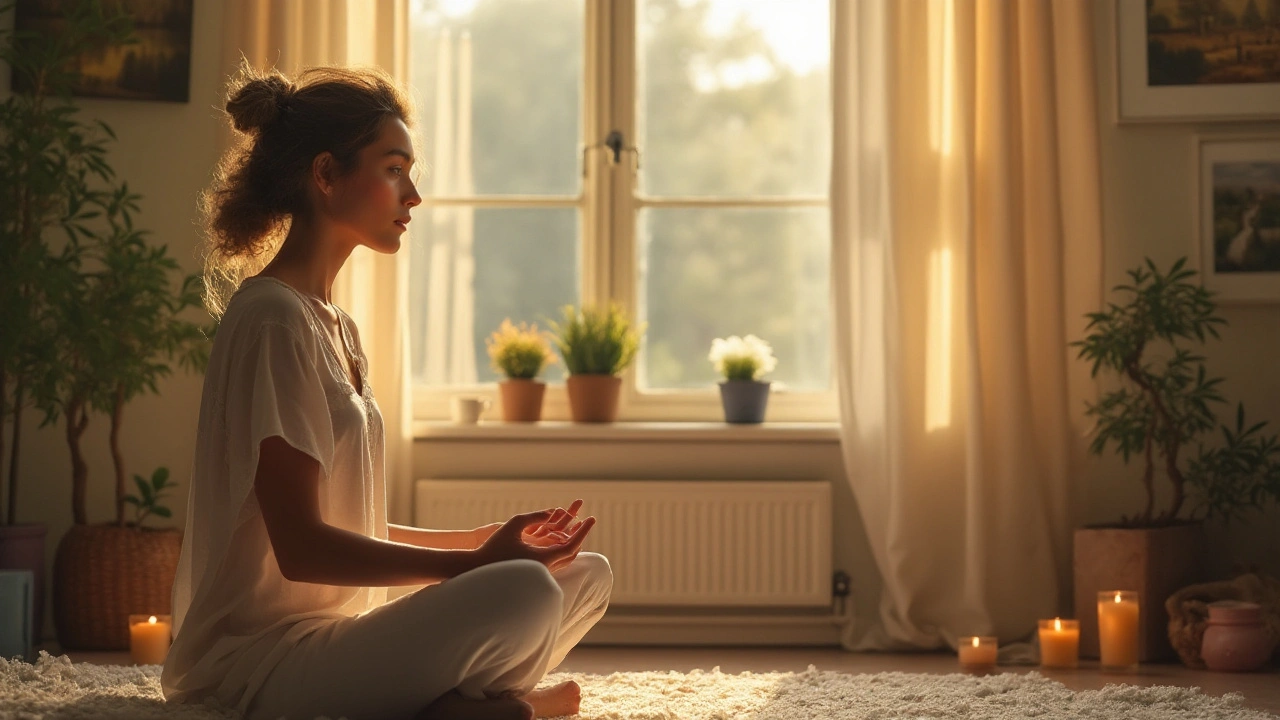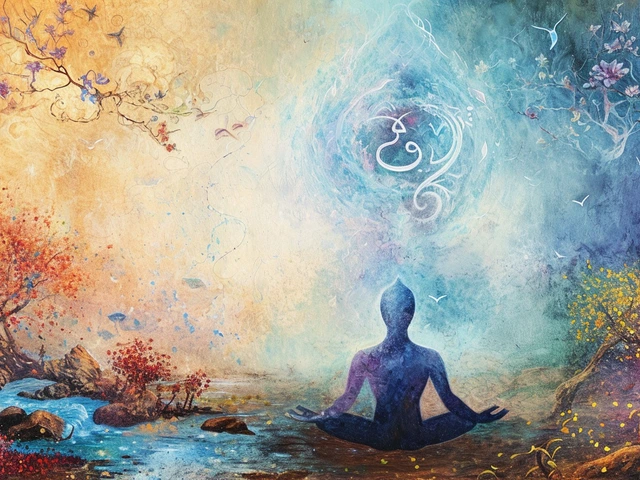Reiki: Unveiling a Natural Path to Chronic Pain Management

Imagine living a life where your persistent pain seems to ease, not with another prescription pill or invasive procedure, but through the gentle, ancient practice of Reiki. This Japanese technique, shrouded in serenity and simplicity, has been a solace for many seeking relief from chronic pain. It revolves around the understanding of universal energy flow, where skilled practitioners channel this profound energy to stimulate the body’s natural healing mechanisms.
The essence of Reiki lies in restoring balance to the body’s lifeforce energy, which often becomes disrupted in states of discomfort or illness. People struggling with relentless pain find hope in Reiki's non-invasive touch, which is intended to enhance their sense of well-being and peace. As more dive into this alternative healing world, the question emerges: how does this mystical practice stack up against the dominant medical approaches of today? Let’s explore its potential and promise in managing chronic pain.
- Understanding the Basics of Reiki
- How Reiki Alleviates Chronic Pain
- The Science Behind Reiki and Energy Healing
- Integrating Reiki into Daily Pain Management Practices
Understanding the Basics of Reiki
Reiki, with its origins deeply rooted in the rich tapestry of Japanese culture, is an art form of healing that resonates with simplicity and depth. The term 'Reiki' translates directly to 'universal life energy,' a fitting descriptor for a practice that aims to harmonize and balance the energy forces within the body. Tracing back to the spiritual insights of Mikao Usui in the early 20th century, Reiki emerged as more than just a healing modality; it became a philosophy of life, encouraging practitioners to live with purpose, kindness, and a deeper sense of awareness. The foundational principle of Reiki revolves around the belief that an unseen energy flows through all living things, and it is the very essence that keeps us alive. When this life force energy is low, we are more likely to feel sick or stressed, but when it is high, we are equipped to achieve happiness and good health.
The Reiki process begins with a non-intrusive laying of hands, which is thought to allow a natural flow of energy between practitioner and recipient. During a session, a practitioner taps into the energy reservoirs of the universe, channeling it through their hands to the patient. The recipient may experience a sensation of warmth, tingling, or simply profound relaxation. This journey is complemented by the five Reiki principles which encourage healing not only of the body but of the soul: let go of anger, worry not, be grateful, do your work honestly, and be kind to all living beings. Embracing these can often lead to transformative changes in a person’s life, far beyond the physical realm.
Reiki's appeal lies in its gentle yet powerful capacity to promote self-healing. As opposed to conventional methods often characterized by chemical intervention, Reiki provides a nurturing space where healing is fostered through human connection and empathy. Studies have shown significant improvements in various conditions post-Reiki sessions, ranging from chronic pain to anxiety disorders. According to Pamela Miles, a renowned Reiki master and author, "Reiki practice can bring a sense of clarity and empowerment in ways we have yet to fully understand, but the effects are undeniable." As societies become more receptive to alternative therapies, Reiki stands as a testament to the profound healing accessible through subtle energy work.

How Reiki Alleviates Chronic Pain
Reiki's approach to chronic pain relief is deeply rooted in the concept of energy flow through and around the body. Pain and discomfort are often perceived to be manifestations of disruptions or blockages in this energy flow. Through gentle, hands-on techniques or sometimes even through no physical contact at all, Reiki practitioners aim to channel healing energy into these disrupted areas. The goal is to clear blockages and restore optimal energy balance, potentially resulting in a reduction of pain.
This method of healing offers more than just pain reduction. Many recipients report experiencing a profound sense of relaxation and stress reduction, which according to experts, is crucial in managing chronic pain. According to a study published in the Journal of Evidence-Based Complementary & Alternative Medicine, participants who received Reiki sessions reported a significant decrease in pain levels and an increase in emotional well-being. Reiki is also believed to stimulate the parasympathetic nervous system. This branch of the nervous system plays a crucial role in promoting relaxation and 'rest-and-digest' functions, counteracting the 'fight-or-flight' responses that often exacerbate pain symptoms.
Patients suffering from conditions like fibromyalgia or arthritis may find Reiki sessions beneficial as they often lead to a calm state of mind, which can enhance the body's natural healing processes.
"Reiki brings about deeprooted transformations in one's energy system," says Dr. Ann Baldwin, an expert in psychophysiology and Reiki research, adding more weight to the growing evidence that supports Reiki's benefits on chronic pain management. With a session that typically lasts between 60 to 90 minutes, the hands of the practitioner hover over or lightly touch the patient's body, progressing through known points of energy accumulation.
Importantly, integrating Reiki with traditional pain management strategies can sometimes result in more comprehensive care. These integrative approaches often provide patients with increased opportunities for relief, blending the advantages of medical science with holistic philosophies. Reiki doesn’t necessarily replace conventional medical treatments but can offer synergistic effects when used as part of a broader, multifaceted approach to pain management. This practice encourages a holistic view of health, acknowledging the complex interplay between the body's physical, emotional, and spiritual layers.
Finally, it is crucial to choose a trained and preferably certified Reiki practitioner to ensure the best outcome. While scientific evidence continues to expand, many healthcare providers are recommending Reiki treatments as complementary therapies, emphasizing a patient-centered approach that values the role of individual preferences in care. As more people explore Reiki as a viable alternative, its potential as a sustainable component of chronic pain management becomes ever more apparent, offering new hope to those in need.

The Science Behind Reiki and Energy Healing
In the realm of complementary medicine, Reiki stands out for its unique approach to wellness, focusing on the flow and balance of energy within the body. While modern science continually seeks to understand its mechanisms, this therapeutic practice operates on the premise that life force energy can be harnessed and directed to promote healing. Such energy, often termed 'ki' or 'chi', is central to the technique, where practitioners aim to clear energy blockages that may lead to physical discomfort or emotional imbalance.
Scientific perspectives on energy therapy like Reiki often meet with skepticism, primarily due to the challenge of measuring something inherently intangible. However, studies have shown promising results. A 2008 study published in the Journal of Alternative and Complementary Medicine found that Reiki significantly reduced pain compared to sham treatments in postoperative patients. These findings suggest a physiological basis for Reiki’s effects, which may include the activation of the parasympathetic nervous system, allowing the body to relax and heal.
Moreover, the aspect of touch in Reiki sessions is not to be underestimated. Physical touch has been documented to have numerous benefits, such as the release of endorphins and a decrease in stress hormones. This may contribute to Reiki's soothing effects. The focus on stress reduction is pivotal, as chronic stress is a known amplifier of pain symptoms. The calming nature of a Reiki session, often in a tranquil setting, complements its physical effects, facilitating a holistic healing process that intertwines body and mind.
"Science explores the roots of healing traditions, uncovers patterns, and offers validation; yet some aspects, like those of energy therapy, persist in realms beyond quantification," remarked Dr. Rachel Novak, a leading researcher in integrative medicine.
Explorations into energy fields continue to evolve, with biofield therapies being a subject of increased academic interest. Scientists are beginning to use advanced imaging technologies to study the subtle biofields around living organisms. Such studies aim to bridge the gap between traditional healing practices and contemporary scientific methods, potentially offering new insights into how Reiki and methods like it exert their pain-relieving effects.
As the medical community opens its doors wider to integrative practices, Reiki increasingly finds its place in hospitals and clinics alongside conventional treatments. Its integration is bolstered by health practitioners advocating for a full spectrum of care that treats more than just symptoms. The acceptance hints at a growing recognition of the benefits of holistic approaches, helping individuals live with chronic conditions more comfortably and peacefully. This convergence of ancient wisdom and modern science symbolizes a profound shift towards more empathetic healthcare.

Integrating Reiki into Daily Pain Management Practices
Reiki's calming presence can become an integral part of a regular pain management routine, offering a supplementary path alongside conventional therapies. By adopting Reiki, individuals might discover new levels of energy and relief that might have seemed out of reach before. To start, it's vital to understand that Reiki requires consistency and openness. Like any practice aimed at holistic healing, persistence and willingness to embrace its nuances can enhance its effectiveness. Many practitioners recommend starting with guided sessions under a seasoned Reiki master, which can help tune individuals into their own energy flows, ensuring they learn the techniques right. Over time, once familiarity sets in, incorporating self-Reiki becomes simpler, allowing individuals to conduct short sessions on themselves.
A heartening aspect of Reiki, especially for those wary of complex regimens, is its simplicity and serenity. Daily practice does not demand specialized equipment or excessive time, making it accessible to anyone, anywhere. Beginners may find it helpful to weave Reiki into their morning routine or use it as a way to wind down at night. For instance, spending just 15 minutes in a quiet space, focusing on specific pain points or areas that feel out of equilibrium, can significantly enhance comfort and reduce tension. Even small, consistent efforts can weave Reiki seamlessly into daily life, subtly altering one's experience of chronic pain over time.
Creating the right environment is another key component in this integrative approach. A tranquil space, free from distractions, can amplify the meditative aspect of Reiki, allowing the mind and body to relax into the flow of energy. Some practitioners incorporate elements like calming music, soft lighting, or even subtle aromas from natural oils, all aimed at centering the mind and amplifying the energy's impact. This layered approach can elevate the practice, encouraging deeper relaxation and fostering a more profound healing experience. It's in this state of calm that Reiki works its rejuvenating magic, aiding in the reduction of stress and the relief of chronic discomfort.
To guide this integration, reflecting on feedback from existing practitioners can provide invaluable insights. As renowned Reiki Master William Rand notes, "Reiki offers a meditative engagement with life's energy, subtly altering our alignment with pain."
This quote encapsulates the essence of Reiki's capability to transform the perception of chronic pain.The testimonials of those who have explored this path can inspire newcomers, showing tangible steps and potential benefits. Sharing experiences in community groups or online forums can also offer support and ensure that individuals do not feel isolated on their healing journeys.
Consistency is critical as one navigates this serene journey of self-healing. Just as with other wellness practices, it might be tempting to delay or skip sessions, especially when results aren't immediate. However, with Reiki, patience pays off. Keeping track of progress through a journal can be beneficial. Documenting symptoms, emotional changes, and overall shifts in pain perception helps track how effectively Reiki is harmonizing internal energies over weeks or months. Such a record can also guide adjustments in the practice, helping fine-tune techniques to better suit individual needs.





